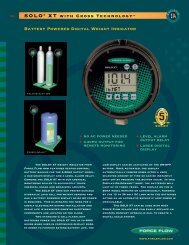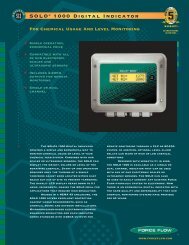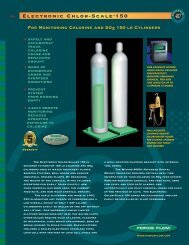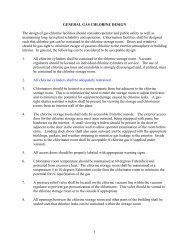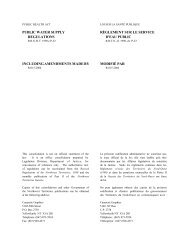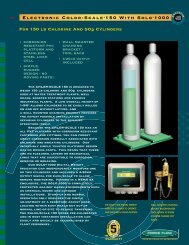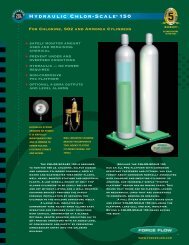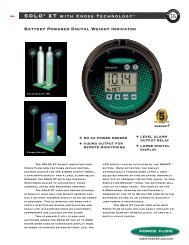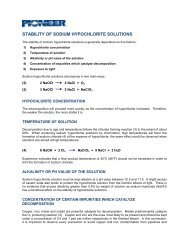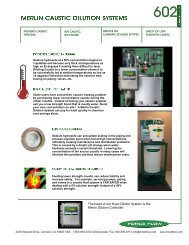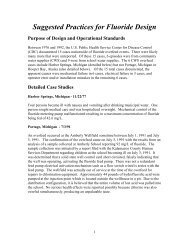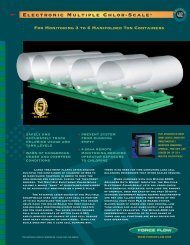Sodium Hypochlorite Handbook - Force Flow
Sodium Hypochlorite Handbook - Force Flow
Sodium Hypochlorite Handbook - Force Flow
Create successful ePaper yourself
Turn your PDF publications into a flip-book with our unique Google optimized e-Paper software.
For example:Assume the storage tank is 8,000 gallons in volume.Assume the old bleach remaining in the tank is 2000 gallons.Assume the old bleach was delivered at 120 gpl available chlorine, it is now one weekold, and now it has decomposed to 100 gpl.Assume the new bleach is 120 gpl and is a shipment of 5000 gallons.After mixing of the old bleach with the new bleach, the final mixed solution will be approximately 114 gplavailable chlorine with higher levels of chlorate due to the old bleach decomposition.Assume a week later at the same ambient conditions as previous week the sameamount of bleach of 2000 gallons remaining.Now the 2000 gallons of stored bleach will be lower than 100 gpl, for example 95 gpl since it was lowerto start with due to the dilution of the old with the new.Therefore, it is critical for the end user to always have two tanks for storage and use sodiumhypochlorite out of each tank to the lowest level before any new bleach is received. The twotanks should be alternated in use for the best results. Bleach strength can not be maintainedand can not be controlled if this is not done.2.4.2.3 Method #3 to reduce <strong>Sodium</strong> <strong>Hypochlorite</strong> DecompositionChlorate Formation Path #2In many countries it is common to ship strong sodium hypochlorite (> 60 gpl available chlorine) verylong distances in hot climates and store it a week or two before final sales to the end user. If this is acommon practice for the supplier, the end result will be a delivered product that is low in strength. Thisis not an acceptable practice.All bleach decomposition is dependant on temperature. For any given temperature, the higher thestrength, the faster it decomposes. In order to completely understand the decomposition of bleach withrespect to strength versus temperature please refer to the AWWA research document “MinimizingChlorate when <strong>Hypochlorite</strong> is the Chlorinating Ion.” In summary, for every 10 o C increase in storagetemperature, the sodium hypochlorite will decompose at an increased rate factor of approximately 3.5.Another relative indication of bleach decomposition is the Rate constants (k2) of sodium hypochloritedecomposition. Below is a table to show these rate constants of decomposition with respect to strengthand temperature.<strong>Sodium</strong> <strong>Hypochlorite</strong> (NaOCl) Weight %Temperature 15.89 13.46 10.82 7.93 4.7455 250 189 138 98.2 65.545 80.7 58.7 43.9 30.2 19.335 23.1 17.0 12.2 8.43 5.4525 6.33 4.68 3.22 2.19 1.5815 1.65 1.15 0.80 0.53 0.30



